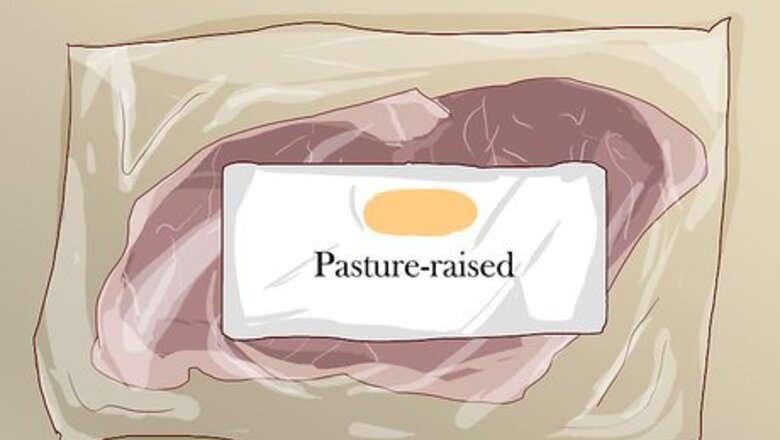
views
Decoding Labels

Look for a pasture-raised label. You want to make sure any grass-fed meat you buy was pasture-raised. Labels can be deceiving because organic and grass-fed meat does not always mean the animals were raised on a pasture. In general, raising animals on a pasture is more ethical, as animals were allowed to roam freely. Also, pasture-raised animals may have a healthier diet. Grass-fed beef is higher in omega-3s than conventionally raised beef, so it is healthier for your heart. However, you should always look for multiple labels. Pasture-raised does not mean the farm grew crops without pesticides or that the animals were never fed artificial grains or given antibiotics. Pasture-raised is only one of many labels you should look for when choosing meats.
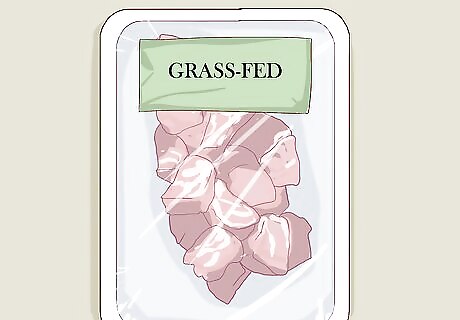
Make sure the label specifies grass-fed. Grass-fed animals were probably not fed artificial products, or these products were at least not their primary food source. However, not all grass-fed animals were fed grass year round. Some labels are more authentic than others. Try to find a grass-fed label from the American Grassfed Association. In addition to assuring animals were grass-fed year-round, this also indicates the animals were raised humanely prior to slaughter. When possible, select grass-fed labels from local farmers. You can ask specific questions that may not be answered by a label.

Find an organic label. An organic label does not give a lot of information about your meat, but it's good for meat labeled organic that also contains labels like pasture-raised and grass-fed. The United States Department of Agriculture (USDA) requires certain standards be met for meat to be labeled as organic. Organic meat must be raised using organic food sources that minimize use of antibiotics and chemicals. Animals are also generally hormone free. However, like all labels, you should not rely on an organic label alone. Native fish may be less regulated than other meats, and the USDA does not have specific requirements regarding controlling methane emissions from cattle. Opt for meat that comes with the organic label alongside other labels, like grass-fed and pasture-raised.
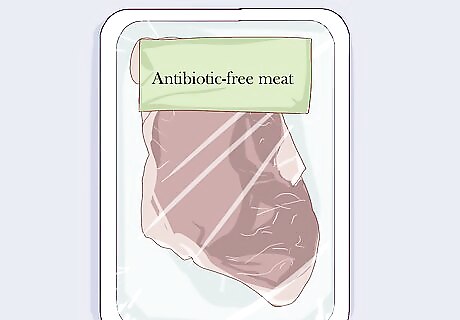
Opt for antibiotic-free meat. Animals are often fed antibiotics to promote growth. Products labeled "antibiotic-free" are not necessarily 100% free of antibiotics. However, the use of antibiotics was likely minimized in such products. The label "USDA Process Verified" can be particularly deceiving, as such animals likely spent some time on a factory farm when being raised. Similarly, the label "antibiotic free" does not mean the animals were never fed antibiotics. In general, smaller independent farms are less likely to use antibiotics. When possible, seek out meat locally from a farmer you can talk to face-to-face.

Skip labels altogether. Labels can only tell you so much about how animals were fed and raised before slaughter. If you want to make sure your meat really was grass-fed and organic, consult a local farmer. You can reach out to a local farmer you find through the yellow pages or online. You can also find farmers at a local farmer's market. Buying meat directly from a farmer will allow you to have any questions you have about the quality of the meat answered directly.
Selecting Quality Meats

Identify a good cut of beef. You want to make sure you choose quality meat when selecting organic meats. When choosing beef, look for physical indications the beef is high quality. Higher quality beef will have brown edges. It will also have visible fat that is yellow-colored. Beef can come in a variety of colors, from mahogany to deep brown. Color is not necessarily an indication of freshness. When the meat is labeled in terms of fat percentages, look for beef that is 90% lean. Quality beef will not have an unusual smell. It should smell like you would expect meat to smell and should not give off a rancid or unpleasant odor.

Pick the right poultry. If you're buying poultry, like chicken or turkey, look for indicators the meat is high quality. Keep in mind that poultry cannot be grass-fed because this is not what they like to eat. Look for poultry that is labeled as organic and free range. Once you've found a brand of poultry with all the right labels, identify markers of quality. Poultry should be plump in appearance. The skin should be free of any cuts and bruises. Packages should be free of cuts and tears, as this keeps poultry fresh. You should also only buy poultry from a store that stocks meat daily. Frozen poultry should be completely frozen through. There should be no ice crystals on the packaging or the poultry.

Select sustainable, wild-caught seafood. Most seafood will not be labeled as organic. Instead, choose wild-caught seafood that is labeled as “certified sustainable.” These are the greenest options available when choosing seafood. Check the seafood for quality and freshness as well. Whole fish should have bright pink eyes and gills. Avoid fish that has a graying or dusty appearance. Fillets should be somewhat translucent in appearance with no brown edges. Shellfish such as oysters should have completely closed shells with no signs of outside damage. Shellfish sold without the shell in place, such as shrimp, should be firm with a slight odor and a bright appearance. Fresher fish will lack a strong, fishy odor.
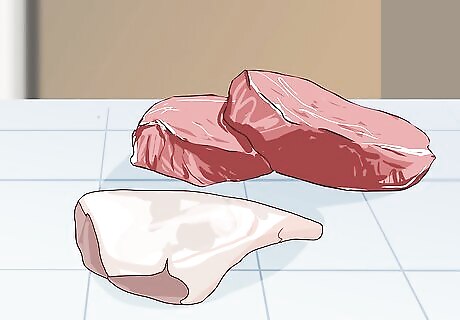
Choose other meats carefully. You can also find other types of organic meats, such as pork and lamb. Lamb may be grass-fed also, but pigs do not eat grass so you will not be able to get grass-fed pork. When selecting meat, make sure the meat is prepared carefully. In addition to being organic, look for general signs of quality. While color varies depending on the type of meat, color should generally be fairly uniform. The texture should be fairly tight and uniform. Loose or broken fibers can be an indication of poor quality meat. The meat should be cut properly. Cuts of meat should be roughly the same size and shape and there should be no uneven edges.
Choosing Cost Effective Options
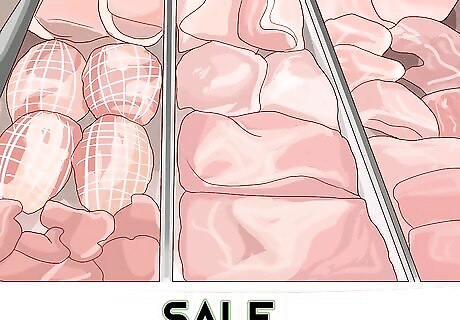
Wait for a sale. Unfortunately, grass-fed and organic meats are often more expensive than other meats. If you're on a budget, keep your eye out for a sale at your local supermarket. Be on the lookout in the local paper for sales. You should also check receipts for coupons and save any coupons for meat you receive when checking out. Keep in mind that organic meats will always be higher in price, even when at discounted prices. If there's a big sale, stock up on organic meats now and freeze them for use later on.

Seek out a farmer's market or buy directly from a farm. In addition to saving you some money, buying directly from a farmer has other benefits. You are able to ask questions about how the animals were raised and whether things like antibiotics were used directly. If you have a local farmer's market, make this your source of organic meat. You can also look into local farms. Many local farms are willing to sell meat directly to the consumer. If you have a relationship with a local farmer, they may give you a discount.

Find alternatives when necessary. You may not always be able to find organic meat in your price range. Strive for alternatives in these situations. If you hunt, or know someone who does, wild game can be a good option. If health is an issue, you can opt for lean meats. If are looking for nutrient-dense meats on a budget, then consider organ meats. Be mindful, however, that these types of meats are often very high in cholesterol. If you want to buy organic grass-fed meat for ethical reasons, try making vegetarian meals if you can't find ethically ranged meat.
















Comments
0 comment